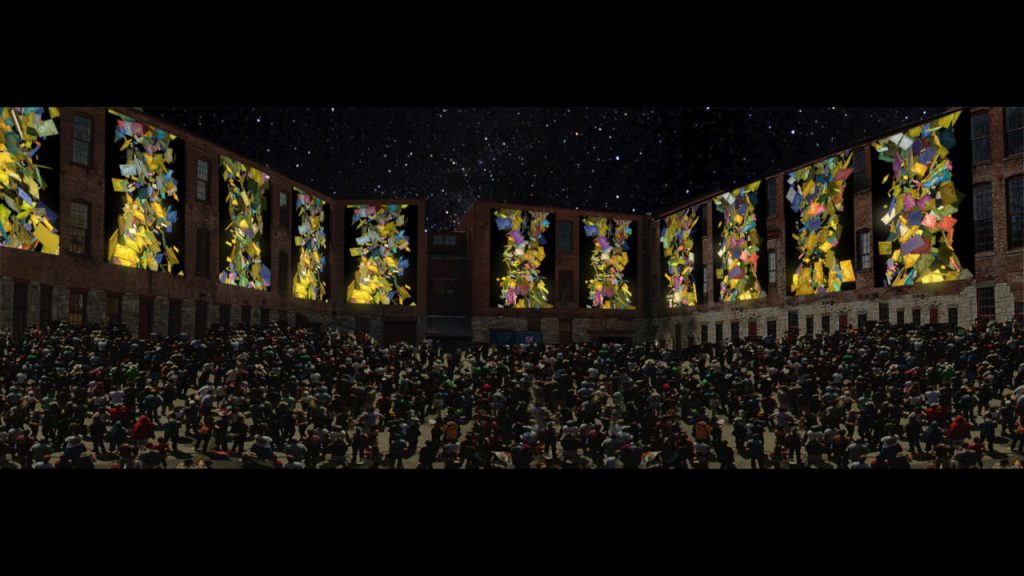How Clifford Ross Uses Music and Art to Express the Emotions that Words Can’t


Harmonium Mountain video still courtesy of Clifford Ross Studio
We live our lives surrounded by people, but experience is individual. We use words to externalize ideas and feelings but, at best, they’re a rough sketch of the nebulous phenomenon that is consciousness; words are discrete, but living is fluid and murky.
And yet, for the most part, we keep using words. Because while it’s fun to have feelings about things we encounter, it’s more fun to have the same feelings as other people, at the same time—and language is the most convenient way to make that happen, even if—and when—it falls short. And when that happens? That’s where music comes in.
New York-based artist Clifford Ross is obsessed with communicating individual experience–most importantly, the feeling of experience–in dimensions beyond words. If he’s standing in hurricane-strength waves tethered to a rope inundated by gorgeous water molecules that swirl in and out of each other before crashing to the surf, he takes stupendously high resolution pictures of them so you can feel inundated by them, too. Ross is obsessed with using technology to replicate natural phenomena–in figurative and abstract form–to share the many and nuanced dimensions of being in their presence.
Tonight, as part of Bric’s Celebrate Brooklyn! Performance Arts Festival at Prospect Park Bandshell, Ross premieres an oversized, multi-screen video installation of one of his favorite natural forms–a hyper-cropped section of his favorite mountain peak in Colorado. The 71-minute presentation translates the colossal rocky landscape into moving, hyper-colored pixels, accompanied by live music from the Orchestra of St. Luke’s, an ensemble with a reputation of being particularly dexterous with regards to genre; it can just as easily perform Bach as back up Metallica, which it honest-to-goodness did do at Madison Square Garden in 1999. With The Musical World of Harmonium Mountain, Ross aims to expose another dimension of his favorite mountain through music—and the selections are varied, from Vivaldi, to Steve Reich, and a recent composition by The National’s Bryce Dessner
Ross grew up obsessed with music, but unable to play it. (He failed at eight different instruments, “possibly nine,” he says, if you count the recorder.) So he began consuming it prodigiously to make up for his inability to perform it. More recently he read an essay by Walter Pater that helped him understand why music meant so much to him–all art, it said, aspires to the condition of music.
“I realized for me and most people, it goes right into the heart and soul, it’s a main-line i.v.,” Ross explained earlier this month, walking through his own mid-career retrospective at MASS MOCA. Which is to say, music has the mystical quality he strives for with his art—the ability to hit the viewer, unmediated, with meaning and emotion.
Things got more exciting when he realized music could be an ally to his art. “I’ve learned that art is first of all activated by the viewer–it doesn’t exist until the viewer’s participated–so the idea that a collaborative process could include music, to me, became a thrill,” said Ross, as he strolled to a first-viewing of Harmonium Mountain in an open air courtyard, under a steady rain, shown in 17 million 600 thousand falling pixels at MASS MOCA a few weeks ago.
In that presentation, Frank Sinatra transitioned seamlessly into Satie, and each musician said something different, yet right, about the hyper colored splices of Ross’ mountain. (Ross originally came up with the name “Harmonium” to describe his abstract interpretation of the mountain when he remembered that the yellow and turquoise creatures in Kurt Vonnegut’s The Sirens of Titan, which subside on very low frequencies of sound, are called Harmoniums.)
Ross isn’t bashful about sharing his feelings about music, but he doesn’t want it to be a crutch for his art: The visual component should stand its own, he says. He becomes giddy by music’s ability to nudge the things he makes into new directions he can’t foresee. Phillip Glass was the first to write a score for Harmonium Mountain–an idea Ross floated to Glass casually, once, at a social gathering. To hear Ross recount the first time he listened to Glass’s music, composed for a video he would show at the Santa Fe Bienniel, is to watch a man recount a spiritual experience.
“Liron Unreich, my long time studio collaborator, said, ‘We just got something from Philip Glass,’ Do you want to listen to it?’ And he had a funny look in his face, and it was to the beat, five minutes and 26 seconds of absolute magic. It was done on a synthesizer on the road, and I had tears in my eyes. Unreich was equally moved. We just couldn’t believe it.”
For the performance tonight, Ross says the process of selecting the music came down to other people who know music much better than he does (he worked side with AJ Benson, Director of Artistic Administration for Orchestra of St. Luke’s) and his own gut.
“You gotta find the right sonic match. With AJ, we stretched it,” said Ross. “I originally wanted to go way, way back, the earliest to Vivaldi and Bach.” But then Benson helped him find a Polish composer named Wojciech Kilar from 20 years ago, said Ross, who he had never heard of; as soon as he listened, it blew him away, an immediate sonic match. Next a friend connected him to Bryce Dessner; finally, he couldn’t stop himself from including Steve Reich.
“We have 20 musicians on stage and one vocalist. There are seven pieces, orchestrated for 70 minutes and five screens. It’s gonna be wild.”
Which has to be an understatement. A video installation of an abstract form of a digital picture of a mountain summit in Colorado that is named after a creature created by Kurt Vonneget’s head and set, in part, to music from Bryce Dessner, must, in the least case, be wild. More importantly, the things it will make you feel will be real, and shared with others.
You might also like 




















